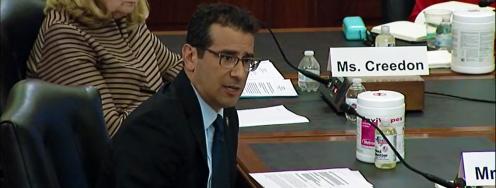GAO: Pentagon Lowballing Nuclear Costs
On the radar: DoD omits two legs of the triad in its budget estimate; the Boomer bailout; B-2s sent to Europe; Rep. Quigley on the costs of NATO nukes; Ten years of GTRI; Buying ways out of ICBM irrelevance; Transparency and nuclear diplomacy; the USEC disaster; and Terrifying new info on that time we almost nuked North Carolina.
June 11, 2014 | Edited by Lauren Mladenka and Geoff Wilson
Nuclear Modernization Omissions - The GAO has “identified shortcomings with respect to the completeness of the budget estimates and the transparency of the assumptions and limitations that underlie the … Departments of Energy's (DOE) and Defense's (DOD) $263.8 billion, 10-year estimates in their report to Congress for sustaining and modernizing U.S. nuclear weapons capabilities.”
--Significantly, the report found that the “DOD's $125.5 billion estimate in the report does not include potential budget estimates for Air Force efforts to modernize intercontinental ballistic missiles or to develop a new bomber. Instead, DOD treated these efforts as zero-cost in the estimate. Consequently, DOD may be significantly underreporting its 10-year estimate, depending on the magnitude of the costs resulting from upcoming decisions about how to modernize these delivery systems.” Furthermore, the GAO found that “DOD's methodology for preparing its $40.8 billion estimate to sustain and modernize its system for assuring connectivity between the President and nuclear forces is not fully transparent because key assumptions and potential limitations are not documented in the report to Congress. As a result, Congress has a limited basis for understanding the estimate, or for comparing the estimates in one annual report to the next, as it assesses long-term affordability when allocating resources.”
--The DOE shared much of the criticism, with the GAO reporting that the “DOE's $97.5 billion estimate in the report includes less funding than will be needed through fiscal year 2018 to meet program milestones for planned nuclear weapon life extensions, and through fiscal year 2023 to meet milestones for constructing key facilities.” Read the full report here. http://1.usa.gov/SN84o5
Boomer bailout - “Members of Congress and Navy officials were wringing their hands late last year over a roughly $60 billion shortfall forecast between 2021 and 2035 in the Navy’s 30-year shipbuilding plan,” writes Frank Oliveri for Roll Call. “Two-thirds of that expected shortfall would result from the $93 billion program to replace the Navy’s Ohio-class nuclear-powered ballistic missile submarines. Such a cost might reduce the amount the Navy would have to buy some other kinds of ships, with the result that it would take two decades for the Navy to increase its battle force from its current 288 ships to its goal of 306.”
--The House and Senate armed services committees are trying to find free money for the subs. “They have included provisions in their respective fiscal 2015 defense policy bills (HR 4435, S 2410) that, with a stroke of the president’s pen, could significantly relieve the strain on the Navy’s shipbuilding plans. Rather than pay for the submarines from the Navy’s regular budget, the bills would create a special National Sea-Based Deterrence Fund to cover the cost of the Ohio-class submarine replacement. By elevating the submarine program directly under the control of the secretary of Defense — not unlike the Missile Defense Agency — lawmakers hope to avoid having the Navy’s top priority competing for money with its other warships, at least directly. With both committees supporting the idea, it is a virtual lock to become law.” Read the full report here. http://bit.ly/1kmxVcU
Tweet - @armscontrolnow: Video of 6/10 event at Wilson Ctr on #Iran nuclear talks w/Stephen Hadley, .@DarylGKimball of @armscontrolnow, others http://bit.ly/1hIwnzc
Spirits in Europe - “The Air Force on Sunday announced it was deploying two more nuclear-capable bombers to Europe on top of the three aircraft sent over last week,” Global Security Newswire reports.
--“Last week, the Air Force deployed three nuclear-capable B-52 bombers to Europe for training operations. The Sunday press release said the B-2 bombers were on a short-term mission to the U.S. European Command area of operations that would provide ‘opportunities for aircrews to sharpen skills in several key operational sets and become familiar with airbases and operations in the region.’” Read the full report here. http://bit.ly/1hOvy8v
Tweet - @nukes_of_hazard: Missile Defense Agency Director Adm Syring tells SAC-D that upcoming GMD test will include target that has "countermeasures package"
Cost sharing - “[U.S.] Representative Mike Quigley (IL-05) offered language that was successfully included in the FY2015 Defense Appropriations bill calling on North Atlantic Treaty Organization (NATO) allies to provide proportional funding for forward deployed nuclear weapons in Europe. The U.S. currently shoulders the vast majority of annual operating costs, spending approximately $100 million to maintain these weapons each year according to the Pentagon, and costs are scheduled to rise as the weapons are modernized and new delivery systems and aircraft are developed.”
--“‘American taxpayers shouldn’t be expected to pay the entire bill for a nuclear weapon arsenal in Europe designed to fight a Cold War that no longer exists,’ said Rep. Quigley. ‘As we reassess our 21st century fiscal and strategic needs and the cost of maintaining our European arsenal rises, it is not unreasonable to expect our NATO allies to share a proportional amount of the burden.’” Read the full press statement here. http://1.usa.gov/1in6IHq
Stopping nuclear nightmares - “Ten years ago, the Bush administration launched the Global Threat Reduction Initiative (GTRI)—an effort to get potential nuclear bomb material out of vulnerable research facilities around the world, and to remove or beef up security for radiological materials that could be used in a ‘dirty bomb,’” writes Matthew Bunn in a piece for The National Interest. “GTRI has been remarkably successful. Since its May 2004 launch, it has removed over four tons of highly enriched uranium (HEU) and plutonium from countries around the world (or in a few cases, confirmed that they had eliminated the materials themselves), helped eighteen countries to eliminate all of the weapons-usable nuclear material on their soil, converted forty-eight reactors so they no longer use potential bomb material as fuel, removed 36,000 dangerous radiological sources, and upgraded security for some 1,600 buildings where dangerous radiological or nuclear material resides.”
--“Ten years on, GTRI has done a great deal, but a great deal remains to be done. Unfortunately, and inexplicably, despite President Obama’s call to accelerate nuclear-security improvement around the globe, his budget proposal calls for cutting GTRI’s budget by 25 percent—after years of previous cutbacks. Unless Congress acts to reverse these cuts, efforts to convert reactors away from potential bomb fuel, to develop new fuels so more reactors can be converted, and to protect and recover dangerous radiological sources will all be slowed.” Read the full piece here. http://bit.ly/1hNbOSq
Correcting failures - “The Air Force is launching an ambitious campaign to repair flaws in its nuclear missile corps, after recent training failures, security missteps, leadership lapses, morale problems and stunning breakdowns in discipline prompted Defense Secretary Chuck Hagel to demand action to restore public confidence in the nuclear force. Air Force leaders are planning to offer bonus pay to missile force members, fill gaps in their ranks, offer a nuclear service medal and put more money into modernizing what in some respects has become a decrepit Minuteman 3 missile force that few airmen want to join and even fewer view as a career-enhancing mission.”
--“The potential impact of these and other planned changes is unclear. They do not appear to address comprehensively what some see as the core issue: a flagging sense of purpose in a force that atrophied after the Cold War ended two decades ago as the military's focus turned to countering terrorism and other threats.” Read the full piece by Robert Burns for the AP here. http://bit.ly/1lakwtb
Pushing restart - “Beijing and Washington are studying multiple paths for restarting frozen nuclear negotiations with North Korea,” reports Global Security Newswire. “South Korea, the U.S. and China have been seeking various options to resume a meaningful dialogue on denuclearization [with North Korea]." Read the full report here. http://bit.ly/SN5wXk
Charges filed - “Singapore said on Tuesday it has filed criminal charges against a company implicated in an illegal shipment of arms seized near the Panama Canal last year on a North Korean container ship,” writes Rujun Shen in Reuters. “The charges come after a U.N. report in March which named Chinpo Shipping as helping arrange the shipment of Cuban fighter jets and missile parts that were bound for North Korea when they were seized in Panama last July.” Full article here. http://reut.rs/SJj1XN
The T-word - “Transparency is an elusive commodity in international nuclear affairs,” writes Mark Hibbs for Arms Control Wonk. “Routinely cited as a universal virtue and not without a certain sanctimoniousness, this aspiration is sacrificed time and time again on the altar of political expediency. Transparency doesn’t factor into the IAEA’s routine work in Iran, which is mostly about monitoring and verifying the accounting of declared materials and activities. Instead, it’s a battleground in the IAEA’s efforts to arrive at a holistic picture of Iran’s nuclear history, including things that Iran, so far, has not seen fit to declare. That includes what the IAEA calls ‘possible military dimensions’ (PMD) of Iran’s nuclear program.”
--“Complete transparency would imply that the roles of the IAEA and the powers would be absolutely separate: The IAEA and Iran would confer in a different box from Iran’s negotiations with the powers, along the lines of the Framework for Cooperation which Iran and the IAEA concluded last November just before the powers and Iran followed up with the JPOA. When both tracks are finished the IAEA Secretariat, fully autonomously, would inform the Board of Governors about what it knows.” However “the real world is not so cut-and-dried. It might be useful to think of the state of play like a Venn diagram where the circles represent the interests and views of individual member states (including Iran and each of the six powers) plus the IAEA Secretariat; decisions emerge in the space where these sets intersect. Left to itself, that space might be quite opaque.”
--In that light, it may make sense that the U.S. may have “pressed the IAEA to accept what it calls “limited disclosure” of PMD activities to facilitate making a deal with Iran.” Indeed the Foreign Policy Research Institute “documents that, since negotiations with Iran have accelerated after the election of President Hassan Rouhani, personalities involved in how the powers frame the PMD issue have departed from the view that Iran must “come clean” or “confess” that it had a nuclear weapons program… That brings us full circle to the T-Word. If the powers, the IAEA, and Iran all agree at the end of the day that they aim to retire the PMD conundrum, what will they say and on what basis will they decide? One conclusion by FPRI’s author might suggest that they will want to disclose as little as possible: “Insisting on full transparency may well jeopardize the progress of the negotiations.” Full story here. http://ceip.org/TJF0yN
USEC violations - “The Energy Department, in an effort to prop up a troubled uranium enrichment company, arranged for uranium transfers that failed to comply with laws about fair pricing, national security determinations and limits to prevent the department from flooding the domestic uranium market, the Government Accountability Office said in a report released to the public Monday. The company, USEC, ceased enrichment activities in May 2013 and declared bankruptcy in March 2014, battered by weak demand from nuclear plants, its outdated enrichment facility in Kentucky and a shortage of capital to invest in new technology and a plant in Ohio.”
--“The GAO examined four transfers of uranium by the Energy Department in 2012 and 2013 that indirectly provided USEC with operating cash. The GAO said that the Energy Department sometimes put a value on uranium transfers — known as tailings — taken from its vast stockpile while other times treating them as worthless or even an environmental liability, the report said. It said that the department transferred enriched uranium from USEC in March 2012 for what it said were national security reasons, then transferred it back to USEC in March 2013 without obtaining a needed presidential determination.”
--“The entire Ohio congressional delegation and the Energy Department have defended USEC, saying it provides jobs and that it is needed as the only American-owned enrichment company to supply material to make tritium for U.S. weapons. Many experts dispute this, saying that the military has enough tritium to last a couple of decades… The GAO report said that the Energy Department had failed to obtain a presidential order before selling part of its uranium inventory, thus violating the Atomic Energy Act of 1954.” Read the full report from Steven Mufson for The Washington Post here. http://wapo.st/1jirzf3
Disaster narrowly averted - “There are few things in this world that can change the course of history faster than a nuclear bomb exploding. The devastation is immediate and lasts for years,” writes Dan Lamothe in The Washington Post. “That makes the latest details to emerge about a Jan. 24, 1961, incident involving two nuclear bombs all the more jarring. A B-52 bomber broke up in the sky over North Carolina, and one of the two bombs on board was in the ‘armed’ setting by the time it hit the ground near Goldsboro, N.C., according to a newly declassified report published Monday by the National Security Archive. If the switch had not been damaged by the impact of the crash, the weapon could have detonated, the report said.”
--“The so-called ‘Goldsboro incident’ received widespread attention in the fall, when details about the incident were published in a new book, ‘Command and Control,’ by Eric Schlosser. And it sounds just as ominous as described Monday by Bill Burr of the National Security Archives. ‘The report implied that because Weapon 2 landed in a free-fall, without the parachute operating, the timer did not initiate the bomb’s high voltage battery (‘trajectory arming’), a step in the arming sequence,’ Burr wrote. ‘For Weapon 2, the Arm/Safe switch was in the ‘safe’ position, yet it was virtually armed because the impact shock had rotated the indicator drum to the ‘armed’ position. But the shock also damaged the switch contacts, which had to be intact for the weapon to detonate.’” Read the full article here. http://wapo.st/1oS0qU4
Quick-hits:
--“Nuclear Weapons Transparency” by Jeffrey Lewis in Arms Control Wonk. http://bit.ly/1kmipO6
--“Nuclear Timelines: U.S. Perspective” in The Iran Primer. http://bit.ly/TJyNmv
--“Iran’s Dissidents, Released But Not Freed” by Robin Wright in The New Yorker. http://nyr.kr/Utoa82
Events:
--“Regional Implications of a Nuclear Deal with Iran.” Senate Foreign Relations Committee hearing with Dennis Ross, Scott Modell, and Frederick Kagan. June 12 at 10:00 at 419 Senate Office Building. Webcast available here. http://1.usa.gov/SgNUSW
--“Securing Radiological Materials: Examining the Threat Next Door.” Senate Committee on Homeland Security hearing. June 12 at 10:30 at 342 Dirksen Senate Office Building. Webcast available here. http://1.usa.gov/1k0X5xr
--“War With Iran? Should the United States Use Military Force Against Iran if Nuclear Diplomacy Fails?” Debate with Georgetown University and University of Michigan students; comments by Colin Kahl. June 13 from 9:00-12:00 at the Willard Intercontinental Hotel, The Willard Room, 1401 Pennsylvania Ave. NW. RSVP here. http://bit.ly/1gXWlOJ
--“Ukraine, Deterrence in the 21st Century, and the Nuclear Weapons Budget.” Discussion with Mieke Eoyang, Benjamin Friedman, and Pete Sepp. June 16 at 10:00am at 340 Cannon House Office Building. RSVP by email to erosenkranz@pogo.org
--“India’s Nuclear Policy and Regional Stability.” Discussion with Michael Krepon, Lt. Gen. Vinay Shankar (ret.), Vice Adm. A.K. Singh (ret.), Joshua White, Vikram Singh, and Jayant Prasad. June 16 from 12:30 to 3:00 at the Stimson Center, 1111 19th St. NW. RSVP here. http://bit.ly/1s0k0Db
--“How to Unwind Iran Nuclear Sanctions.” Discussion with Kenneth Katzman and Cornelius Adebahr; moderated by Barbara Slavin. June 16 at 2:00 at The Atlantic Council, 1030 15th St. NW, 12th Floor (West Tower). RSVP here. http://bit.ly/1h9DpN2



